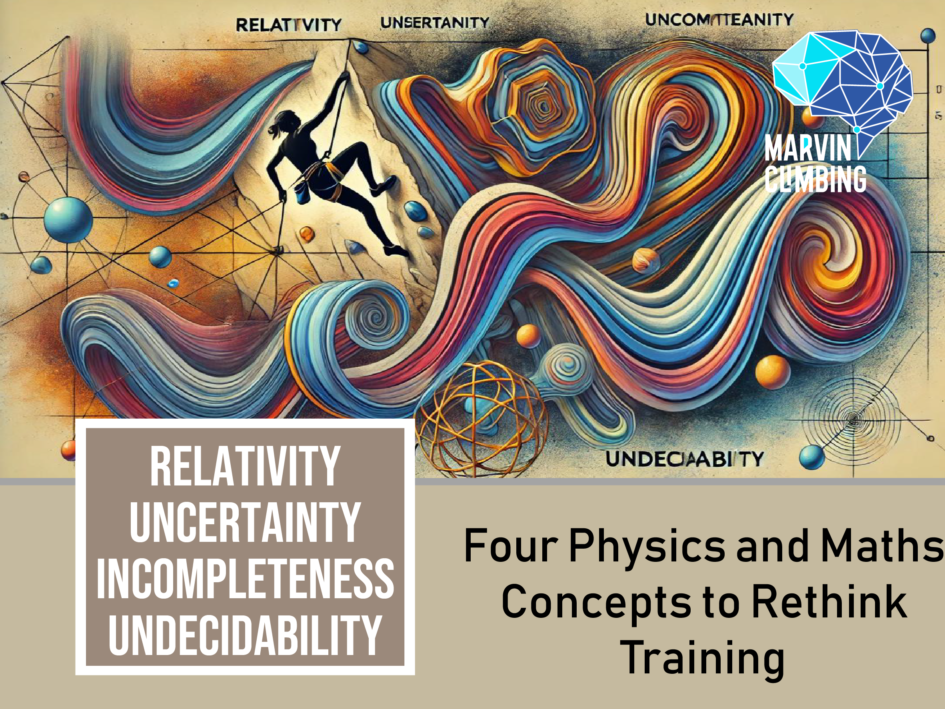Four Maths and Physics Concepts to Rethink Training
Although these four concepts come from different areas of physics and mathematics, they share a common point: all of them address the limits of what we can know, measure, or predict. This is a free interpretation of the concepts and is not intended to be scientifically rigorous, but rather a framework for reflecting on training.
1. Relativity
Albert Einstein’s theory of relativity, published in 1905, is known for predicting phenomena such as the slower aging of astronauts compared to people on Earth, or the change in the shape of objects at high speeds. However, relativity can also be understood in a broader sense: how we perceive something depends on our point of view or our relationship with what we are observing.
In climbing, for example, the perception of effort determines the intensity of a route or circuit. There is no standard pattern: the grading of a boulder or a route depends on the perception of effort both from the route setter and the climbers. Now, if we have two climbers with the same technical level but one with a higher workload, emotional stress, or academic pressure, their experience will be different. For the climber who had a calm week, the planned session may be suitable for generating the desired adaptations, while for the other, fatigued by stress, that same session may seem overly exhausting. Although both are doing the same training, their perception varies. Relativity in training shows us that effort is always subjective and depends on the athlete’s physical, mental, and emotional state.
2. Uncertainty
Heisenberg’s uncertainty principle states that we cannot know two complementary properties exactly at the same time, such as position and speed. Translated into sports, this concept reminds us that there is an indeterminacy between immediate performance and optimal recovery.
An athlete seeking to improve quickly by training with high intensity may achieve short-term gains but risks not properly gauging their recovery status, increasing the chances of overtraining. On the other hand, if they focus too much on recovery, they may lose progress due to a lack of stimulus. The challenge for the coach is to balance these variables, knowing that there will always be a degree of uncertainty regarding the athlete’s form and their responses to training.
3. Incompleteness
Gödel’s incompleteness theorem states that in any sufficiently complex logical system, there will be questions that cannot be resolved within the system itself. There will always be unanswered questions within the limits of that framework.
In sports training, especially in disciplines like climbing, this becomes evident in the constant evolution of the sport. Boulder movements, for example, have become more dynamic and flashy in recent years. Sometimes, neither coaches nor climbers have a clear answer to certain new challenges. In these situations, creativity becomes an essential tool for finding solutions beyond the established system.
4. Undecidability
The concept of undecidability, formalized by Alan Turing in the 1930s, refers to problems that cannot be solved by an algorithm in a finite amount of time. In other words, these are questions that have no definitive solution through a formal method.
Let’s think about the planning of a training session. No matter how detailed and careful it is, we can never be completely sure we’ve found the best possible combination of exercises, intensity, and rest. There is always the possibility that a better option exists that we haven’t considered. This concept reminds us that training is a process of constant trial and error, where perfection is unattainable, but adaptability is key.

The role of the coach in training planning involves recognizing that, just like the concepts of relativity, uncertainty, incompleteness, and undecidability, there will always be limits to what we can predict and control. The coach must adjust their approach according to the individual needs of each athlete, manage the inevitable uncertainties between workload and recovery, and be willing to explore creative solutions when clear answers do not exist. The perfect plan does not exist, but a flexible and adaptable approach will allow for maximizing performance within these limitations.
Prof. Juan Martín Miranda



Leave a Reply